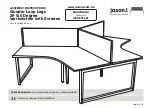
23
ADJUSTMENTS AND OPERA
ADJUSTMENTS AND OPERA
ADJUSTMENTS AND OPERA
ADJUSTMENTS AND OPERA
ADJUSTMENTS AND OPERATIONS
TIONS
TIONS
TIONS
TIONS
Basic excavation technique:
When starting an excavation, make a first flat cut of each section, taking care
to follow exactly the established outline for the excavation. The reason for making a
flat cut is to minimize demage to the upper part of the opening.
These first cuts are also important because they will serve as guides for other
cuts. Thus, if the first cuts are well done, it will help to ensure that all the others are well
done.
To excavate with the Tatu Back Hoe, extend the boom, the arm and the bucket
towards the front. Lower the boom and the arm to begin the excavation process.
The teeth of the bucket should be between 30 and 45 degrees. At the start of
the excavation, pull up the bucket until the cutting edge is level with the horizon, fill
the bucket in the direction of the operator, working with the control lever of the bucket
to maintain its level. When the bucket moves away from operator manipulate the
arm lever to maintain the level of the cut. At the end of the excavation cycle, pull
the bucket up completely and extend the arm while raising it out of the excavation.
Once the bucket has been emptied, return the unit for more excavation, positioning
the bucket and the boom for the next cut in the process. The whole excavation
process should be a smooth cycle that is repeated until it is finished.
When about 15 cm of the desired depth has been excavated, clean and finish
the walls of the ditch. Use the flat sides of the bucket to compact what has been
removed. Remove any exposed loose stones. When compacting the walls, start with
the farthest ones, moving the bucket and the boom towards the outside and forcing
the bucket down. To compact the nearest wall, raise and pull in the bucket.












































